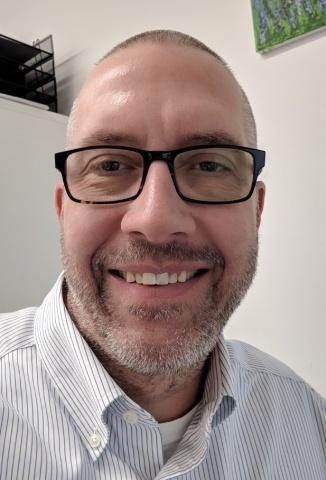
Thirteen years ago, Matthew Tackitt was working in the financial sector, when the 2008 global economic crisis and cross-country move got him thinking about a career change. He opted for nursing and has stuck with it ever since. This May, Tackitt joined the Movement Disorders clinic as their navigator for their Deep Brain Stimulator (DBS) Program. For this week’s “Spotlight” interview, Tackitt talks to us about the amazing difference DBS can make it patients’ lives, the various positions he’s held for the past 13 years, and working out, writing, and volunteering with rescue pit bulls when he’s not at Duke.
What are your current responsibilities within the Neurology Department? What does a typical day look like for you?
I am the navigator for the Deep Brain Stimulator Program. I am helping to build a program that coordinates movement disorder neurology, neurosurgery and neuropsychology so that our patients can be quickly and efficiently assessed to determine if they are a good candidate for a deep brain stimulator. I am the liaison between our patients and our program, and I perform many of the video assessments for our patients. I also help out with a couple of Duke’s current projects research regarding deep brain stimulation.
How and when did you first get interested in nursing? What do you enjoy most about working with deep brain stimulation patients in particular?
I went into nursing after 13 years in the financial industry working with investments, estate planning and tax law. My wife is a nurse practitioner and I decided to make a career change. I enjoy explaining the complexities of deep brain stimulation to our patients in simple and easy to understand terms. I really enjoy watching the amazing results and symptom relief they receive once the stimulator is placed. It’s almost magical the difference these stimulators can make in people’s quality of life.
How and when did you switch from the financial industry to health care?
In 2008 when the financial crisis hit, we had just moved to North Carolina from Denver, Co. Because of the economic turmoil, there were no finance jobs available. My wife told me if I wanted to make any kind of career change, right now may be the time. I thought that if I could combine my finance degree and experience with something in health care that may open a lot of opportunities for me. So I decided I wanted to go to nursing school.
What was the biggest surprise you encountered when making that change?
Going into health care I was like many patients, I thought there was a pill for everything and that we had ways to fix everything for people. We don’t. There are many things we can’t fix, and we just manage the symptoms. And all those pills have side effects. It’s amazing we can do as much as we can do, but there is still so much room for growth and development in healthcare services. Research and technology play big roles in that.
Before joining the Movement Disorders division, you were a faculty member of the nursing programs at Alamance Community College and Haywood Community College. What were your roles there? What did you enjoy most about that work?
I taught Nursing School before re-joining Duke. It was a great experience. I enjoyed the lectures and lessons, but the fun parts are the skills labs and the clinicals in the hospitals. It’s rewarding to see the sparkle in a student’s eye when they have that “Ah ha!” moment understanding why a disease process does what it does or how a therapeutic intervention helps our patients. It was great to get to work with the next generation of new nurses.
Among other positions you also worked in the Duke Spine and Pain Management Clinic in Raleigh and the Carolina Family Practice and Sports Medicine Clinic. How did your work in those positions compare to what you’re doing now?
From a nursing role, those positions were very different from what I am doing now. It was my work with spinal cord stimulator in the pain management clinic that helped me get my position at the Cleveland Clinic working with their deep brain stimulator program. They are similar interventions and medical devices, just used in different ways. Moving back to North Carolina, I have been able to bring my experience and success from Cleveland to Duke.
What’s one thing you wished more patients and their loved ones knew about DBS?
So many of the medicines we use for our patients have serious side effects. Sometimes, after many years, those medicines just don’t work as well as they use to. Deep brain stimulation is a powerful, non-medicinal alternative for many different neurological based movement disorders: Parkinson’s disease, essential tremor, dystonia and some aspects of Tourette’s syndrome. The research, some of which is happening here at Duke, is looking at ways to expand the use of deep brain stimulation into other disorders such as epilepsy, strokes and narcotic addiction.
What other passions or hobbies do you have outside of the Department?
I enjoy working out and writing. I like to take my wife and kids kayaking. My wife and I volunteer and donate to pitbull rescues.

Tackitt and his wife Helen enjoy the outdoors and time with rescue pitbulls when they're not at work.